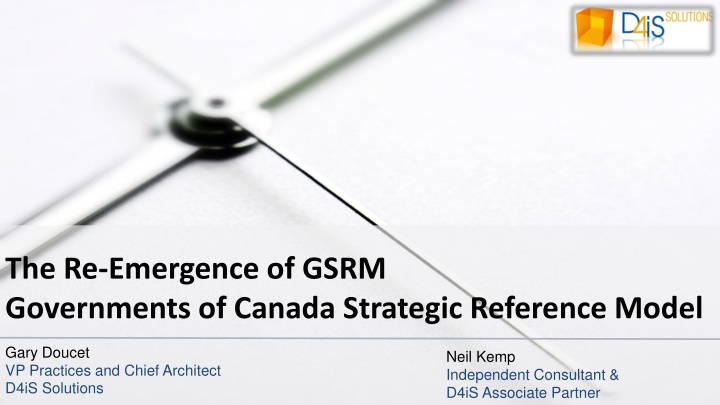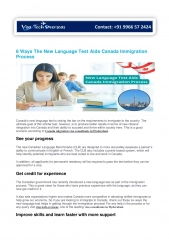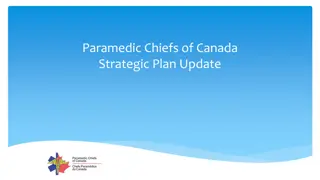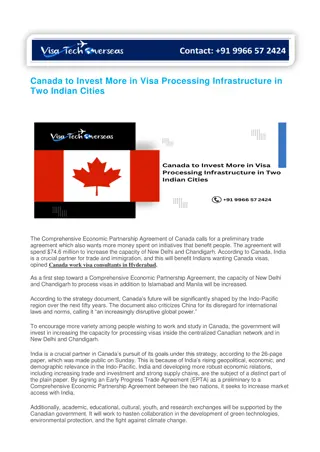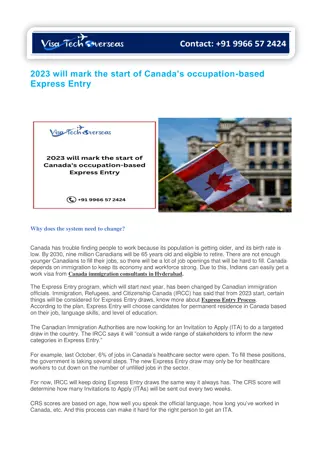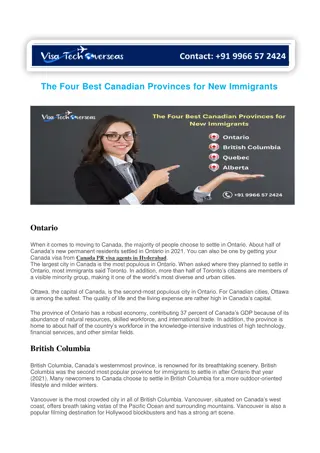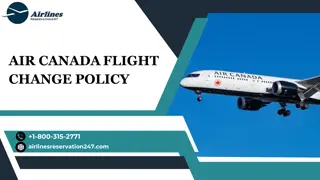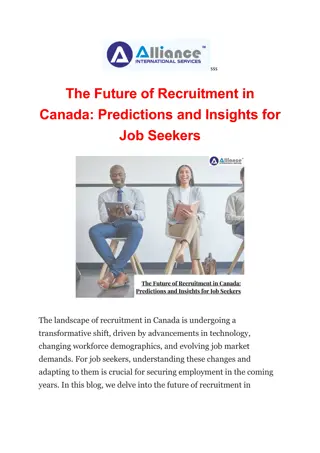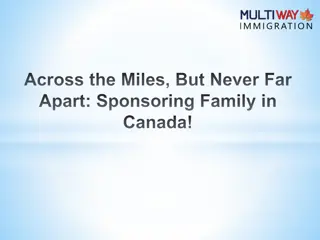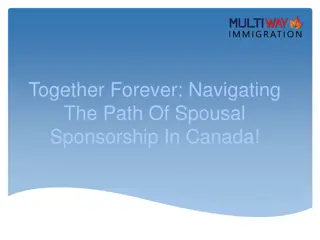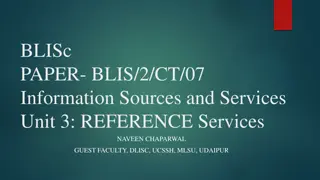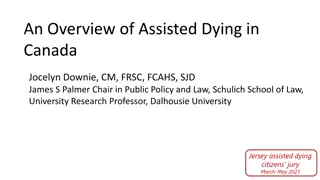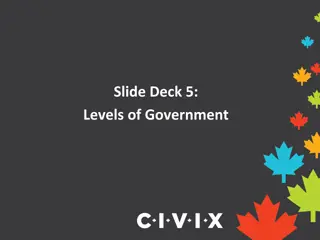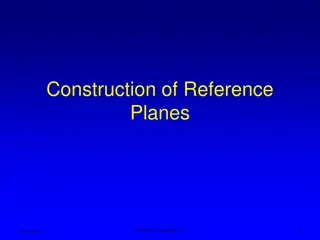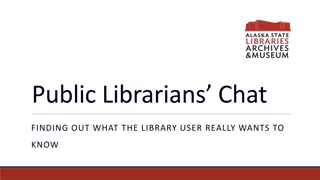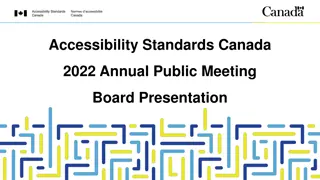The Re-Emergence of GSRM - Governments of Canada Strategic Reference Model
The public sector reference model work done in Canada from the 1990s, particularly the Governments of Canada Strategic Reference Model (GSRM), showcases efforts towards better governance practices. This model, focusing on service delivery and outcomes, has been influential and is now being reconsidered for further enhancements. The narrative explores the evolution and potential future directions of reference models within government settings.
Download Presentation

Please find below an Image/Link to download the presentation.
The content on the website is provided AS IS for your information and personal use only. It may not be sold, licensed, or shared on other websites without obtaining consent from the author.If you encounter any issues during the download, it is possible that the publisher has removed the file from their server.
You are allowed to download the files provided on this website for personal or commercial use, subject to the condition that they are used lawfully. All files are the property of their respective owners.
The content on the website is provided AS IS for your information and personal use only. It may not be sold, licensed, or shared on other websites without obtaining consent from the author.
E N D
Presentation Transcript
The Re-Emergence of GSRM Governments of Canada Strategic Reference Model Gary Doucet VP Practices and Chief Architect D4iS Solutions Neil Kemp Independent Consultant & D4iS Associate Partner 1
Lets build a house Yes we should Sometimes there is a weakness in words. 2 But there is a power in models. EA in the GC: Government of Canada
Summary The public sector reference model work done in Canada, starting in the early 1990 s, was and still is considered by some to be best in class. The GSRM (Governments of Canada Strategic Reference Model) was the GC version and it seemed to drop from sight (as well as pan-Canadian efforts) around 2009. Support did fade but it was more accidental than intentional. There are still pockets of interest, use and enhancements. The governments of Canada are wondering what to do next. Is it time for Open Group involvement? 3
Context: Timeline 1990s MRM: Municipal Reference Model developed (Winnipeg) A standard way to describe services and enable Service Based Costing 1995-2000 PSRM: Public Service Reference Model (Ontario) 2002-2004 GSRM: Governments of Canada Strategic Reference Model (GC) 2004-2006 BTEP V2.0 Released (with GSRM). 2006-2007 GSRM Meta Model Created Presented to UN/CEFACT for consideration as a standard. 4 BTEP Business Transformation Enablement Program
Context: Timeline 2007-2008 Decision to create CGRM (Canadian Governments Reference Model) Will start by offering GSRM content but need to do IP review first To be managed ICCS (Institute for Citizen Centered Service) A unified model for all orders of government Issues Lengthy legal research surrounding IP with GSRM/BTEP stole time from operationalization agenda EA team at GC moved to embedded model and Reference Model leadership discontinued 5 ICCS Institute for Citizen Centered Service An NGO serving federal, provincial and municipal governments of Canada
Why a Reference Model? To answer questions correctly, consistently, and efficiently: How many programs and services do we have? What services do governments provide to a target group (i.e., seniors, youth, indigenous)? How much do we spend to deliver those services? Are the services achieving the intended outcomes? How do we best deliver seamless client-centred services from multiple governments? How much are we investing in internal services per external service? These seem like simple questions but they are hard to answer, especially in aggregation. 6
Why a Reference Model? And to design well Ensure solution accomplishes outcome. Align execution to strategy To align projects to each other. To align business units to each other. To deliver unified, seamless, accurate and proactive service to clients. 7
Why a Reference Model? Improving Business Change Planning Fosters a common government-wide approach to design: Provides a common reference point for business program/service design. Helps express and understand the whole business system as a strategic design. Supports the evaluation of alternate strategies and designs. Requires formal ongoing design governance i.e. aligning investments for business and/or IT change. Advances goals for seamless and interoperable client centric services. Please note use of or . 8
xRM Intro: GSRM Government of Canada Strategic Reference Model (GSRM) A consistent model for describing public-sector business designs A common multi-government public sector vocabulary Common tools and common language for GC business architecture designs Supports stakeholder communication, collaboration and consensus Reusable program/service design patterns Facilitates business designs to be scalable, integrated and aligned Supports rigorous, high level analysis and design across diverse portfolios 9
xRM Intro: GSRM Provider Programs Public Programs Provider program fields are identified by the needs of public programs & other provider programs Public Policy, Planning and Management Corporate Policy, Planning and Management, Integrated Delivery, Communications Management, Human Resources Management, Financial Management, Information Management Information Technology, Supply Chain Management, Administrative Services Facilities, Fleet and Equipment, Professional Services Public program fields are identified by the public needs recognized by the government Public Target Group(s) (Socio-) Economic Development Science and Knowledge Development Natural Resources Environment Protection Public Health Legal, Collective, Democratic & Human Rights Protection Social Development Cultural Development Educational Development Public Safety National Security & Defence Justice 10
xRM Intro - Types of Service Outputs Service Output Type Service Type Acquiring and providing financial resources Providing resources such as goods, equipment, accommodations (apart from funds and human resources) Conducting research Providing care & rehabilitation to people and things Providing education and training experiences Providing recreational & cultural experiences Moving people and things Providing information & advice Brokering, referring, connecting, matching Influencing, advocating, persuading, promoting awareness Funds Supply capacity to act (Units of) Resource New Knowledge Care & Rehabilitation Encounters Educational & Training Encounters Recreational & Cultural Encounters Movements Advisory Encounters Matches, Referrals & Linkages Advocacy and Promotional Encounters Enhance capability to act Facilitate & influence action Periods of Agreement Creating collaborations, negotiating agreements, settling disputes Periods of Permission Regulating, licensing, permitting, certifying, identifying, authorizing Findings Rulings & Judgements Penalties & Periods of Sanction Inspecting & investigating Applying rules & dispensing justice Enforcing compliance, meting out punishment, penalizing Regulation action Periods of Protection Monitoring, warning, guarding, storing, eliminating threats, reducing risks Intervening, responding to threats & emergencies, giving aid, restoring order Interventions Rules (laws, regulations, policies, strategies, plans, designs, standards) Implemented changes Creating and changing rules Core Changing existing organization, practices, systems 11
xRM Patterns GSRM: Over 100 patterns Patterns for: o Service (Value) Measure o Service Measures (~25) o Process Patterns (~ 100) Supports the 19 Output Types Complex enough for all government services Tailorable for Private Sector? 12
xRM Intro: GSRM Model Common Language and Structure Includes: Standard Set of Business Components & Definitions Standard Set of Integrated Business Models & Methods Reusable Business Design Patterns 13 From GSRM
xRM: Can they keep up with today? Time from service intention to operational business can be greatly reduced with fully developed Reference Models. More on that later. What if you wanted to hack a life event (retirement, birth of child, moving)? You would want to bring together every public and private sector service related to that event. Imagine if the reference model categorization of need and/or target group had been applied to service catalogs, application pages, published budget information, or existing on-line services? Improves the speed and accuracy of finding services to invoke (or at least identify). 14
CGRM Governance Aligning Alignment Models CGRM was started with the intention loading it with material from GSRM, MRM, and PSRM. This image reflects the concept of aligning the public sector reference models. CGRM The central concept around CGRM is the attempt to create a single core which all jurisdictions could agree but allowing for some local differentiation. Maximum Middle By default, all models start as CGRM assets (i.e. for all to use). If an asset in the middle cannot be agreed then the part(s) which cannot be agreed becomes part of the localization. 15
BTEP Business Transformation Enablement Program Not the focus of today but it was the home for GSRM. Started as part of Federal Government GOL Program Follow on to GC Federated Architecture Program (FAP) Business focussed: Visions, Designs and Transformations Approach to Strategic Planning & Design, service transformation and business architecture. Currently unsupported but parts still get referenced/used TOGAF 9 references BTEP (Transformation Readiness Assessment) 16
Current Status GSRM: Not actively being maintained by GC. Web assets archived in 2007. Despite lack of formal activity and governance, there are still regular inquiries as to status of work and location of assets for MRM and GSRM. MRM: Still active but quiet on the development front http://www.misa-asim.ca/members/group.aspx?id=135372 PSRM: Still very active in the province of Ontario GO-ITS 56 - OPS Information Modeling Handbook CGRM : Technically managed by ICCS but not actively Link http://www.iccs-isac.org/research/cgrm/?lang=en 17
Current Status Re-Emerging? ICCS: Has asked for a report defining and evaluating different xRM support models ranging from none to full. Is self-supporting and looking for new subscription services to offer its government members Already stewards other government-owned intellectual property Is a natural home for something like CGRM, especially given their service improvement orientation. Authors are: Skip Lumley, Roy Wiseman, and Gary Doucet Collective experience covering all the models Is there a role for an existing standards organization here? 18
A Practitioner's Story GSRM Applied Experience with Strategic Business Design Neil Kemp 19
Experience Consulting services for 15 years full time, as a business architect, using the GSRM Providing advice on questions of interest to executives Much more business than technical questions Increase in questions of transformation of the business to exploit digitally enabled channels 20
GSRM Likes Allows the creation of a repeatable, implementation independent and strategic views of the business to explore issues of purpose, value, accountability. Focuses on things of great interest to executives Exposes gaps and overlaps of a fundamental nature in what the business needs to achieve its mission Provides a tool to explore questions about insourcing/sourcing, merger and divestiture and other strategic questions Sets an important context for investments in capability by first understanding the nature of value to the enterprise 21
Principles for working with the GSRM Maintain a single, integrated view of the business independent of any technology Start with the principle elements of the GSRM; purpose, and value, augmenting the model as necessary to solve client problems Always apply basic data modelling standards to document the reference framework Be evidence based Make the methods repeatable 1. Rules 2. Patterns 3. Principles Gradually use a tool to hold and automate the work Observation: Existing standards do not connect with each other adopting any one advances your maturity. Adopting any other(s) reduces it 22
Reference: Winnipeg Fleet Services (Aug/2006 - Sep/2009) Problem Transform an internal vehicle maintenance organization into a public leasing business Key Results Identified missing features in the business Produced an organization design and job descriptions Extensions to Methods and Tools Developed an evidence based method for designing organization that align to the strategy (Concepts added and integrated Function, Authority) Generated job descriptions from the model 23
Reference: British Columbia Student Loan (Dec/2008 - Jun/2009) Problem Provide an integrated loan application processing and award program Key results A repeatable design for integrated service delivery for a complex set of government programs Extensions to Methods and Tools Development and method and to for describing a Logical Solution Architecture to support a business design Begin rigorously applying the GSRM service process patterns (from the GSRM Pattern Book) as a repeatable tool in the business design process Identified key process patterns that reside below those in the Pattern Book 24
Reference: City of Ottawa (Aug/2009 Sept/2011) Problem Downsize, outsource, insource, and optimize a fleet management service Key Results Guidance on reorganization of operations with insourcing and outsourcing decision built into the design Extensions to Methods and Tools Introduced a process hierarchy to normalize the end to end and top to bottom description of work Extended the GSRM service process patterns/leveraging earlier patterns 25
Reference: Department of Fisheries and Oceans (Sep/2011 Mar/2012) Problem Provide advice on a COTS solution for real property based on a transformed organization Key Results Created a strategic design for real property management Extensions Extended the GSRM service process pattern/leveraging earlier patterns Refined the service, process, and resource performance patterns 26
Reference: HRSDC/ESDC (Oct/2011 Jan/2013) Problem How to integrate the internal operations of the department to provide a shared set of internal services within the department Key Results Integration of SAP and PeopleSoft A recognition that the business problem could be addressed only on a GC wide basis Extensions to methods and tools Extended the reference framework to include Channel, Competency (From Foresight Strategic Planning Method) HRSDC Human Resources and Skills Development Canada ESDC Employment and Social Development Canada 27
Reference: Treasury Board Secretariat (Feb/ 2013 Mar/2017) Problem Define the end to end financial processes for the government of Canada Key Results Using the repeatable patterns created the core models in three months Identified gaps and scoping issues within the software configuration and implementation project Extensions Extended the GSRM service process pattern /leveraging earlier patterns Linked the extended service process pattern to APSC, ITIL, OCEG, COBIT looking for gaps based on these best practices 28
Current work to extend the GSRM Stabilize the extended model and patterns Working to develop prototype software tool to automate the full extended model, patterns, and reference framework Still outstanding A repeatable method of finding logical roles independent of the implementation of the business Research Results Design work that took man years at the start of the process can now produce credible designs in a small number of months with higher quality results Align to APQC, COBIT, OCEG, ITIL, and to IT4IT to gain insight on the impact of size and deployment strategies on the IT value chain 29
Reusable Patterns (under continuous improvement) 40 Service (Value) Measure Patterns (across the 19 service types) 60 Process Measure Patterns 10 Resource Measures Patterns (a work in progress) 1500 Business Capability Types 19 Service Output Types 23 Program Types 60 Functions 900 High Level Processes 5 detailed process types (with 20 detailed processes) 21 Process Exception Conditions 57 logical Solution Types 12 Channel Types (under development) Service and Process Roles Control Types Risk Types 30
What I would like to see Ability to gain the insight about applying the GSRM business architecture with other practitioners. See the GSRM adopted as a standard that will take in the experience of practitioners The GSRM used to provide a mechanism to align and integrate the full architecture stack. Connecting all parts of the design to the achievement of purpose and the delivery of value 31
Architecture Accelerator Using the patterns and appropriate automation we are now shortening the architecture cycle Previous time to create a viable and credible strategic architecture 1-5 person years Use of patterns has reduced the time to 2-10 months Indications that automation will cut the high end in half (still need time to think ) 32
Take Away A logical design that focuses on purpose, value, of a business can be quickly produced using patterns to aide in an informed discussion of the business and to inform decisions about implementation, investment, and technology Notice how few the references there are to technology in the example projects and the strategic nature of the questions asked and answered 33
Summary The reference models are still in use ICCS is looking at how to restart governance Many practitioners (like Neil) have adopted and adapted, it is time to bring the work together If you have comments, suggestions, questions or use case material that you think would be useful for ICCS and the joint council, send them in 34 ICCS Institute for Citizen Centered Service An NGO serving federal, provincial and municipal governments of Canada
Everyone loves standards thats why everybody has one. Contact Information Gary Doucet VP Practices and Chief Architect D4iS Solutions Gary.Doucet@d4is.com Neil Kemp Independent Consultant & D4iS Associate Partner Neil.Kemp@d4is.com 35
Gary Doucet VP Practices and Chief Architect D4iS Solutions Annex: Other References This list was produced nearly a decade ago and is included for context. Much newer examples of usage exist (e.g. DND used BTEP/GSRM extensively in their EA work) but there is not a forum for exchanging that information. 36
Public Sector Reference Models in Action Federal Government Transportation Safety Board Investigations and Information Management Department of Fisheries and Oceans Process and Information Improvement Government of Canada Information Management Transformation Federal Government IT Security Program design Internal Services Transformation GC Services Inventory IT Services Profile Enterprise view of managing IT Public Safety and Emergency Preparedness Canada Interoperability Project Horizontal Files Analysis Starting with climate change. Alignment of the annual budget process (PAA) and the GSRM to extend the use of the structure beyond budgeting / reporting to program design, analysis and transformation. Multi-jurisdictional Seniors Services Mapping Initiative Services for youth. Youth Segment, Service Vision for Canadians Initiative Improving Services to Businesses in the Restaurant Sector Initiative BizPal Multi-jurisdictional permits and license services. Case Study Summary Case Study 37
Public Sector Reference Models in Action Information Management (IM) advantage in planning and design TBS able to forge agreement on what IM is and what an IM program should do, and identify the services necessary to achieve the stated outcomes of the government s IM policy PSEPC advantage in alignment In less than a year, rigorous analysis of Canada s public safety and security community completed, interoperability gaps and problems identified, and iteration #1 of vision to achieve interoperability and enhance information sharing completed Service Canada advantage in realization projects Service mapping for seniors and service vision for youth completed, positioning Service Canada to fast track opportunities for integrated service for two key client groups BizPal advantage in day to day operations Designs and implementation plans for innovations to integrate permits and license services for businesses across jurisdictions are being developed that will not interrupt ongoing service delivery 38
Public Sector Reference Models in Action Labour Market Delivery Agreement Background The LMDA commits both governments to the following goals: The creation of an integrated labour market system designed to achieve a more efficient and effective matching of a skilled labour force with current and emerging needs of employers; The reduction, to the extent possible, of unnecessary overlap and duplication in their labour market development programs and services and the harmonization of their respective programs and services; and The modernization of government services that build a client-centered service culture that offers a seamless, integrated, multi-channel approach to the delivery of government services. (from Recitals of LMDA, signed November 2005) The implementation of the two agreements requires Ontario Government to articulate both what it will deliver to its clients (the business model) and how it will deliver (the service model) 39
Public Sector Reference Models in Action Labour Market Delivery Agreement Scope of Business Model - Existing Programs Provincial (20) Federal (7) Apprenticeship (Classroom) Training Ontario Youth Apprenticeship Program Pre-Apprenticeship Apprenticeship Client Services Modular Training Co-op Diploma Adjustment Advisory Program Apprenticeship Innovation Fund Sectoral Initiatives Fund Ontario Works Job Connect Literacy and Basic Skills Summer Jobs Program Academic Upgrading Apprenticeship Scholarships / Signing Bonus Access to Professions and Trades Local Boards Job Grow Hotline Apprenticeship Tax Credit Ontario Disability Support Program Employment Assistance Job Creation Partnerships Local Labour Market Partnerships Self-Employment Skills Development Targeted Wage Subsidies Federal Job Bank/Labour Exchange 40
Public Sector Reference Models in Action Labour Market Delivery Agreement Opportunities for Service Improvements The Service Mapping process is the methodology that will identify potential improvements of services to Ontario s Training & Employment clients. Through this process, there may emerge some opportunities that fit the vision. For example, opportunities that align with ServiceOntario s vision could include: Integration of Job Grow Hotline and Loans for Tools Call Centres Journeyperson certificate renewal at ServiceOntario kiosks Exam invigilation for apprenticeship certification exams 41 41
Public Sector Reference Models in Action Labour Market Delivery Agreement Applying BTEP/ Service Output Types to Apprenticeship (BTEP Service Output Types) ASSESSMENT REGISTER FEE FOR REGISTRATION (Matches, Referrals & Linkages) (Matches, Referrals & Linkages) (Funds, Revenue) Client ANNUAL SCHOOL FEES IN SCHOOL & ON THE JOB TRAINING RECORD RESULTS FEE FOR EXAM (Findings) (Funds, Revenue) [Note: External transaction] (Education & Training Encounter) SCHEDULE EXAM WRITE EXAM UNDER VIGILATION CERTIFICATION (Rulings & Judgements) (Periods of Permission) (Findings) Journey Person 42 42
Public Sector Reference Models in Action Restaurant Start Up Grouping Services to identify opportunities for common business processes Shows services by type or jurisdiction that must fit together to make a difference for the target group. Defines bundles by identifying services that detect, help or prevent transitions of a target group. Identifies opportunities for common or standardized processes to join up services in the bundle. Service Bundle 3 (Units of) Resource M Road entrance permit R Water connection permit R sewer connection permit R Road entrance permit Service Bundle 4 (Units of) Resource P Liquor Control Board of Ontario Supply Service Bundle 2 Funds M Property tax account F Loan guarantee F ABC G s and C s Funds F Small Business Financing F Northern Community Financing Funds P Corporate Income Tax Account P Retail Sales Tax Account F Goods and Services Tax Account Advisory Encounters R Referral to professional advisor Primary path Going concern restaurant Service Bundle 5 Periods of Agreement M BIA designation Service Bundle 1 Educational& Training Encounters R Small Business Seminar R Professional business advisor P Entrepreneurial Skills Development Course Funds P WSIB Account P EHT Account F Employment Insurance (EI) account F Canada Pension Plan (CPP) account F Targeted Wage Subsidy Educational& Training Encounters R Professional business advisor Educational& Training Encounters R Small Business Seminar P Entrepreneurial Skills Development Course Periods of Permission M Bingo License M Raffle License M Break Open Ticket Seller License M Business License M Sign Permit M Occupancy Permit R Health Permit P Liquor License Permit P Special Occasion Permit P Break Open Ticket 3rd Party Seller Registration P Break Open Ticket Charity Seller License P Raffle License P Bingo Hall Registration P Bingo Event License P Slot Facility Registration P Key Employee Registration P Non-Gaming Related Supplier Registration P Exempt Gaming Related Supplier Registration P Ontario Racing Commission Teletheatre License P Ontario Lottery and Gaming Corporation Product Seller Contract Advisory Encounters R Referral to professional advisor R Business advisor P Ontario Business Report P Investment Advice P Capital Financing Information F Statistical Information Advisory Encounters M Publications R Referral to professional advisor R Business advisor R Publications R Access to Business publications P/R Talk to me session P AGCO information Service P/F COBSC Information for businesses Educational& Training Encounters R Professional business advisor R Food Handling Safety Course certificate Advisory Encounters M Publications R Publications R Access to business publications P/R Talk to me session P Ontario Business Report P/R Small Business Advice and Guidance P AGCO information Service P/F COBSC Information for businesses F Statistical Information Advocacy and Promotional Encounters R Business promotion event R Marketing to areas outside the region New Restaurant operating STOP Restaurant business entity is fully licensed for intended operation Anyone START Legal Business Entity formed Restaurant facility ready Aspiring Entrepreneur Advisory Encounters R Referral to professional advisor R Business advisor Periods of Permission M Road Excavation permit M Building Permit M Site Alteration Permit R Road Excavation Permit Advocacy and Promotional Encounters R Business promotion event Matches, Referrals and Linkages P/R Ontario Works - Halton Placement Rulings & Judgments M Land Severance service M Minor Variance M Re-Zoning M Heritage property alteration approval R Garbage & Recycling pickup ruling Periods of Permission P Incorporation Registration P Partnership Registration P Business Name Registration F Federal Incorporation Registration F Business Number Registration F Trademark registration Periods of Permission R Healthy Heart ceritificate Closed Restaurant Business Penalties & Periods of Sanction M Collected Fines Finding M Site Plan approval R Site Selection Assistance R Floor Plan & Equipment Layout Approval Rules (laws, policies, strategies, plans, ) R Bylaws Rules (laws, policies, strategies, plans, ) F Consumer Products and Labeling standards and regulations Periods of Agreement M BIA designation 20+ permissions Is there an opportunity here? Advisory services are required in each bundle; Is there an opportunity here? 43
Public Sector Reference Models in Action Service Inventory What is it? Initiative to explore requirements, define an information model and formulate implementation recommendations for developing an inventory of services provided by Government of Canada Why is it needed? Provide authoritative list of services offered by the GC Improve citizen access to federal government services Identify the target groups and the needs that specific services are designed to address Provide an information base for evaluating the range of services being offered, identifying overlaps and gaps in service offerings, considering candidates for service transformation Reimagine this in the context of Government as a Platform. i.e. The app store for services. 44
Public Sector Reference Models in Action Service Inventory GC-TBS-CIOB Project Initiated in participation by a number of departments Project deliverables being reviewed Leveraged earlier work on e-Contact, Seniors Portal, CBSC Implications Creating the initial inventory will require collaborative effort and on-going commitment Inventory must have near-term benefit for its stakeholders Need to explore interest from multi-jurisdictional partners Potential exists for outsourcing operations to registry service providers Reimagine this in the context of Government as a Platform. i.e. The app store for services. 45
Public Sector Reference Models in Action Service Inventory Service Inventory Information part of a larger picture Common Service Output (Type) Program Sector Planned Performance External Service Internal Service Reporting to Parliament Dept Planned Expenditure Contact Coordinates Actual Performance Actual Expenditure Service Recipient Service Delivery Cost Allocation Service Owner MAF Indicator Service Name Service Cost Channels Services All Reimagine this in the context of Government as a Platform. i.e. The app store for services. 46 46
Public Sector Reference Models in Action Budget and Planning Government of Canada Initiative Annual planning based on PAA Program Activity Architecture (Now called Program Alignment Architecture) GSRM used to inform internal services. Intent was to move to public services after piloting provider services. Implication: A service listed on the Canada Site would be traceable to annual plan and budget of depts. We d know the cost, the intended result and what it takes to change our services to attain 47
Public Sector Reference Models in Action Transportation Safety Board (TSB) Independent federal agency responsible for identifying safety deficiencies within the federally regulated areas of the Air, Marine, Pipeline and Rail industries by investigating: individual occurrences (accidents or incidents) re-occurring safety issues across multiple occurrences 4000 occurrences and 120 investigations/year Approximately 235 employees 10 locations across Canada No authority to direct changes 48
Public Sector Reference Models in Action Transportation Safety Board (TSB) TSB: Potential Cycles Triggered by a Single Transportation Occurrence Response Cycles Investigation Cycles Safety Investigation Litigation Cycles Change Cycles Wrap-Up Criminal Investigation * Media Coverage Regulatory Changes Regulatory Investigation * Emergency Response Operator Changes Criminal Suits Operator Investigation Transportation Occurrence Wreckage Disposal * Site Management Industry Changes Civil Suits Manufacturer Investigation * Next of Kin Support Manufacturer Changes Coroner Inquest Autopsy Research Studies * 49 *multiple occurrence
Public Sector Reference Models in Action Transportation Safety Board (TSB) TSB: Imperatives for Change Paper-based records management practices could not contend with the volume of electronic information being accumulated on a daily basis Each mode (air, marine, rail and pipeline) and the regional offices employed varied approaches and tools for collecting, analysing, storing, sharing and disseminating information Approved investigation methodology not automated resulting in non-standard application of investigation and analysis techniques Current mode-based IT systems outdated, not standardized, costly to support and not integrated with the investigation process Corporate and legal obligations with respect to federal legislation at risk because of one or more of the above. 50 50
